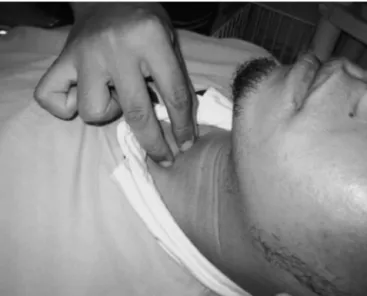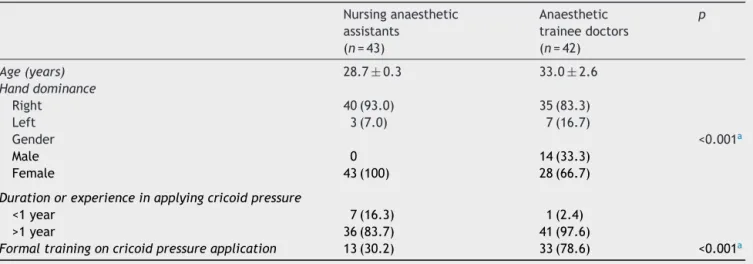REVISTA
BRASILEIRA
DE
ANESTESIOLOGIA
PublicaçãoOficialdaSociedadeBrasileiradeAnestesiologia www.sba.com.brSCIENTIFIC
ARTICLE
Analysis
of
cricoid
pressure
application:
anaesthetic
trainee
doctors
vs.
nursing
anaesthetic
assistants
Nurul
Haizam
Yahaya
a,
Rufinah
Teo
b,
Azarinah
Izaham
b,
Shereen
Tang
b,
Aliza
Mohamad
Yusof
b,
Norsidah
Abdul
Manap
b,∗aDepartmentofAnaesthesiologyandIntensiveCare,TelukIntanHospital,Perak,Malaysia
bDepartmentofAnaesthesiologyandIntensiveCare,UniversitiKebangsaanMalaysiaMedicalCentre,KualaLumpur,Malaysia
Received30September2014;accepted28October2014
Availableonline12May2015
KEYWORDS
Cricoidpressure; Trainee
anaesthetists; Anaestheticassistants
Abstract
Backgroundandobjective: Toevaluate the ability ofanaesthetic trainee doctors compared tonursinganaestheticassistantsinidentifyingthecricoidcartilage,applyingtheappropriate cricoidpressureandproducinganadequatelaryngealinletview.
Methods:Eighty-fiveparticipants,42anaesthetictraineedoctorsand43nursinganaesthetic assistants,wereaskedtocompleteasetofquestionnaireswhichincludedthecorrectamountof forcetobeappliedtothecricoidcartilage.Theywerethenaskedtoidentifythecricoid carti-lageandapplythecricoidpressureonanupperairwaymanikinplacedonaweighingscale,and thepressurewasrecorded.Subsequentlytheyappliedcricoidpressureonactualanaesthetized patientsfollowingrapidsequenceinduction.Detailsregardingthecricoidpressureapplication andtheCormack---Lehaneclassificationofthelaryngealviewwererecorded.
Results:Theanaesthetictraineedoctorsweresignificantlybetterthanthenursinganaesthetic assistantsinidentifyingthecricoidcartilage(95.2%vs.55.8%,p=0.001).However,bothgroups wereequallypoorintheknowledgeabouttheamountofcricoidpressureforcerequired(11.9% vs.9.3%respectively)andinthecorrectapplicationofcricoidpressure(16.7%vs.20.9% respec-tively).Thethree-fingertechniquewasperformedby85.7%oftheanaesthetictraineedoctors and65.1%ofthenursinganaestheticassistants(p=0.03).Therewerenosignificantdifferences intheCormack---Lehaneviewbetweenbothgroups.
Conclusion: Theanaesthetictraineedoctorswerebetterthanthenursinganaestheticassistants incricoidcartilageidentificationbutbothgroupswere equallypoorintheir knowledgeand applicationofcricoidpressure.
© 2015SociedadeBrasileirade Anestesiologia.Publishedby ElsevierEditoraLtda.Allrights reserved.
∗Correspondingauthor.
E-mails:nmanap@ppukm.ukm.edu.my,nmanap@ymail.com(N.AbdulManap).
http://dx.doi.org/10.1016/j.bjane.2014.10.008
284 N.H.Yahayaetal.
PALAVRAS-CHAVE
Pressãocricoide; Residentesem anestesiologia; Assistentesde anestesia
Análisedaaplicac¸ãodepressãocricoide:residentesemanestesiologiavs.
enfermeirosassistentesdeanestesia
Resumo
Justificativaeobjetivo:Avaliaracapacidadederesidentesemanestesiologiaemcomparac¸ão comenfermeirosassistentesdeenfermagemparaidentificaracartilagemcricoide,aplicara pressãocricoideadequadaeproduzirumavistaadequadadaentradadalaringe.
Métodos: Oitentaecincoparticipantes,42residentesemanestesiologiae43enfermeiros assis-tentesdeenfermagemforamconvidadosaresponderalgunsquestionáriossobreaquantidade corretadeforc¸aaseraplicadanacartilagemcricoide.Osparticipantesdeviamidentificara cartilagemcricoideeaplicarapressãocricoideemmodelosdeviasaéreassuperiores coloca-dossobreumabalanc¸adepesagem,eapressãoeraregistada.Posteriormente,osparticipantes aplicarampressãocricoideempacientesanestesiadosreaisapósainduc¸ãodesequência ráp-ida.Osdetalhesasobreaaplicac¸ãodepressãocricoideeaclassificac¸ãodeCormack-Lehane davisibilidadedalaringeforamregistrados.
Resultados: Osresidentesemanestesiologiaforamsignificativamentemelhoresqueos enfer-meirosassistentesdeenfermagem naidentificac¸ãodacartilagemcricoide(95,2%vs.55,8%, p=0,001).Noentanto,oconhecimentodeambososgruposeraprecáriosobreaquantidadede forc¸anecessáriaparaaplicarapressãocricoide(11,9%vs.9,3%,respectivamente)eacorreta aplicac¸ãodapressãocricoide(16,7%vs.20,9%,respectivamente).Atécnicadetrêsdedosfoi realizadapor85,7%dosresidentesemanestesiologiae65,1%dosenfermeiros assistentesde enfermagem(p=0,03).Nãohouvediferenc¸asignificativaentreosdoisgruposemrelac¸ãoà classificac¸ãodeCormack-Lehaneparaavisão.
Conclusão:Osresidentesemanestesiologiaforammelhoresqueosenfermeirosassistentesde enfermagem para identificar acartilagem cricoide,mas ambos os gruposapresentaram um conhecimentoigualmenteprecáriosobreaaplicac¸ãodepressãocricoide.
©2015SociedadeBrasileiradeAnestesiologia.PublicadoporElsevierEditoraLtda.Todosos direitosreservados.
Introduction
Cricoidpressureisanexternalmechanicalpressureapplied ontothe patient’s cricoidcartilage duringrapid sequence induction. Also known as Sellick’s manoeuvre, it was introducedin 1961 tocontrolregurgitationandaspiration ofgastriccontentduringinductionofanaesthesia.1Theuse
ofcricoidpressurefor preventionof pulmonaryaspiration
inhighrisksurgicalpatientsisconsideredstandardpractice
amongstthemajorityofanaesthesiaproviders.2
The routine application of cricoid pressure has been
challengedwith theproblems of impaired laryngeal view,
less effective mask ventilation and unproven benefit in
reducingtheincidenceofaspirationorregurgitation.3The
effectiveness of cricoid pressure is becoming an issue
asmany operators lack the appropriate knowledge about
it. It has been suggested that a proper training
pro-grammeiswarranted toimprovethe cognitiveknowledge
and practical clinical skill of cricoid pressure
applica-tion.Participants whowereunabletoidentifythecorrect
anatomical location of cricoid cartilage were also less
likelytodemonstrate cognitiveknowledge concerningthe
correct amount of cricoid pressure to be applied.2 In
an observational study on African women, Fenton and
Reynold found that cricoid pressure did not provide any
protection against regurgitationor deathin patients who
underwentcaesareansection.4Applicationofcricoid
pres-sure resulted in significant reduction in the mean tidal
volumeandupperairwayobstructionin9---18%ofnon-obese
individuals.5
Inouroperatingtheatres,thenursinganaesthetic
assis-tantswhoroutinely assistintheapplication ofthecricoid
pressurearenotallformallytrained,butreceivedin-house
training. This study was done to determine if they were
comparable with the anaesthetic trainee doctorsin their
abilitytoapplythecricoidpressure.
Methods
Thiswasaprospectiverandomizedsingle-blindclinicalstudy
that evaluated the ability of anaesthetic trainee doctors
and nursing anaesthetic assistants in applying the cricoid
pressure. Prior approval wasobtained from the Research
andEthicsCommittee ofourinstitution. Patients’written
informedconsentwasalsoobtainedbeforetheir
participa-tion.
Thisstudyconsistedoftwoparts.Inthefirstpart,
partic-ipantswereaskedtofillinaquestionnairewhichincluded
age, gender, hand dominance, years of anaesthetic
work-ingexperienceandprevious formaltrainingrelatedtothe
applicationofcricoidpressure.Then,theirknowledgeand
demonstration of the cricoid pressure on an upper
air-waymanikinweredocumented.Theairwaymanikinwitha
clearlydefinedoropharynx,thyroidcartilage,cricoid
Figure1 Modelofupperairwayonweighingscale.
asshowninFig.1.Theweighingscalewascalibratedwith
the modelin placebefore each reading.The participants
wereaskedtoapplythecricoidpressureontothemanikin
as in clinical settings and informed the investigator once
thecorrectpressurehadbeenapplied.Theanatomicalsite
chosen by theparticipant,the technique performed (e.g.
three-finger or two-finger)and the pressureapplied were
thenrecorded.Thenumericaldisplayofthescalewasonly
visibletotheinvestigator.
Inthesecondpartofthestudy,theparticipantsapplied
cricoidpressure onactual anaesthetizedpatients. A total
ofeighty-fiveAmericanSocietyofAnaesthesiologists(ASA)
physicalstatusI---IIIpatients,aged18---70years,who
under-went general anaesthesia with rapid sequence induction
andendotracheal intubationwere enrolled.Patientswere
excluded if there was anticipated difficult intubation,
presence of neck abnormalities or goitre that prevented
effectivecricoidpressureapplication.
Patientswererandomlyassignedtotwogroupsusing
ran-dom sequence computergenerated numbers. In Group A,
cricoidpressurewasperformedbyanaesthetictrainee
doc-torswithatleast3yearsofanaestheticexperience.InGroup
B,cricoid pressure wasperformed by nursing anaesthetic
assistants who were registered staff nurses and routinely
assisted in the application of the cricoid pressure in our
operatingtheatres.Theywerenotallformallytrained,but
receivedonthejobtraining.
Allpatientswerefastedforatleast6handwerenot
pre-medicatedwithsedatives.Standardanaestheticmonitoring
ofelectrocardiography, non-invasiveblood pressure,pulse
oximetryandcapnographywereappliedonallpatients.The
patient’sheadwasplacedonaheadring,withaneck
flex-ionandheadextensionforintubation.Pre-oxygenationfor
3minwasfollowedbyinductionofanaesthesiawith
intra-venousfentanyl2g/kgandintravenouspropofol2mg/kg.
Endotracheal intubation was facilitated with intravenous
suxamethonium2mg/kg. Once thepatientstarted tolose
consciousness,theparticipantsappliedcricoidpressureas
theynormallydid(Figs.2and3).
Figure2 Three-fingertechniqueofcricoidpressure.
Theinvestigatorrecordeddetailsonthecricoidpressure
application,thelaryngealviewbasedonCormack---Lehane
classification, cricoid pressure adjustment requirement,
manipulationsusedandcomplicationssuchasregurgitation
oraspiration.Endotrachealintubationwascarriedoutbythe
anaesthetist 30s after administration of suxamethonium.
Surgerywasallowedtoproceedafterconfirmationofcorrect
placementoftheendotrachealtube.
Data calculated in our pilot study of 15 participants
showedthatasamplesizeof26wasabletodetecta57.8%
differencebetween the twogroups. Using the Powerand
Sample Size Calculation Version 3.0.14, the sample size
requiredwas13patientsperarmbasedonanalphavalueof
0.05andapowerof80%.Thus,atotalofatleast29nursing
anaestheticassistantsandanaesthetictraineedoctorswere
requiredwhenconsideringadrop-outrateof10%.
286 N.H.Yahayaetal.
Table1 Demographicdataofparticipants.Valuesareexpressedasmean±SDandnumber,n(%)asappropriate.
Nursinganaesthetic assistants
(n=43)
Anaesthetic traineedoctors (n=42)
p
Age(years) 28.7±0.3 33.0±2.6
Handdominance
Right 40(93.0) 35(83.3)
Left 3(7.0) 7(16.7)
Gender <0.001a
Male 0 14(33.3)
Female 43(100) 28(66.7)
Durationorexperienceinapplyingcricoidpressure
<1year 7(16.3) 1(2.4)
>1year 36(83.7) 41(97.6)
Formaltrainingoncricoidpressureapplication 13(30.2) 33(78.6) <0.001a
ap<0.05statisticallysignificant.
Statisticalanalysis
Data were analysed with SPSS 17.0 software (SPSSTM,
Chicago,IL).Chi-squaretestwasusedtocomparethe
cog-nitiveknowledgeandactualapplicationofcricoidpressure
andunpaired Student’s t-test for analysisof participants’ age.A p-value of <0.05wasconsidered tobestatistically significant.
Results
Atotalof85participantswererecruitedintothisstudywith 43nursinganaestheticassistantsand42anaesthetictrainee
doctors. There were no drop-outs. As shown in Table 1,
thetwogroups werecomparablewithrespecttotheage,
hand dominance and experience in applying cricoid
pres-sure.However,thenursing anaestheticassistantswereall
females andtheir lack of formal previous training wasof
statisticalsignificance.
Thecorrectcricoidpressurewastakentobeeither30or
40N.Only9.3%ofnursinganaestheticassistantsand11.9%
of anaesthetic trainee doctors gave the correct answer
as shown in Table 2. Both groups were also comparable
in applying the correct pressurewith only 20.9% of
nurs-inganaestheticassistantsand16.7%ofanaesthetictrainee
doctorsdoingitcorrectly.Theanaesthetictraineedoctors
weresignificantlybetterinidentifyingthecricoidcartilage
(p=0.001)with95.2%identifyingitcorrectly comparedto
55.8%nursinganaestheticassistants.Amajorityofthe
par-ticipants performed the three-finger technique of cricoid
pressureapplication,85.7%oftheanaesthetictrainee
doc-tors compared to 65.1% of nursing anaesthetic assistants
(p=0.03).
Table 3 shows there was no significant difference in
theCormack-Lehaneviewsduringtheinitialapplicationof
cricoidpressureinboth groups.Mostofthepatientswere
intubatedwithasingle attempt,97.7% and92.9%
respec-tively.Therewasnoaspirationorregurgitationseeninboth groups.
Discussion
The correctapplicationofcricoidpressureisimportantto
beeffectiveinpreventingpulmonaryaspirationandavoiding
complicationssuchasoesophagealinjuryordifficult intuba-tionduetoimpairmentofthelaryngealview.Technically,it
Table2 Analysisofcricoidpressureonairwaymanikin.Valuesexpressedasnumber,n(%)asappropriate.
Nursinganaesthetic assistants
(n=43)
Anaesthetictrainee doctors
(n=42)
p
Correctlystatedcricoidpressure 4(9.3) 5(11.9) 0.70 Correctapplicationofcricoidpressure 9(20.9) 7(16.7) 0.62 Correctidentificationofcricoidcartilage 24(55.8) 40(95.2) 0.001a
Handthatappliescricoidpressure 0.72
Right 39(90.7) 39(92.9)
Left 4(9.3) 3(7.1)
Technique 0.03a
Three-finger 28(65.1) 36(85.7)
Two-Finger 15(34.9) 6(14.3)
Table3 Theimpactofcricoidpressureonlaryngealview.Valuesareexpressedasnumber,n(%)asappropriate.
Nursinganaesthetic assistants
(n=43)
Anaesthetic traineedoctors (n=42)
p
Cormack-Lehanescoreatfirstattempt 0.27
I 27(62.8) 31(73.8)
II 14(32.6) 11(26.2)
III 2(4.7) 0
Numberofattemptsatintubation 0.29
1 42(97.7) 39(92.9)
2 1(2.3) 3(7.1)
issimplytheapplicationofbackwardpressureonthecricoid cartilage,justinferiortothethyroidcartilage,toocclude theoesophagus.6Thismanoeuvrepromotessafeanaesthesia
butrequires trainedor experiencedpersonneland
consid-erationsofthe anatomicalfeatures,physiological effects,
techniqueandpressurerequirementsanditseffectonthe
easeofintubation.
Our study revealed there was significant knowledge
deficit in the identification of the cricoidcartilage which
is essential for correct cricoid pressure application. The
majority of our anaesthetic trainee doctors (95.2%) were
abletoidentify,but only55.8%ofthenursing anaesthetic
assistantswereabletodoso.Lowidentificationresultsby
nursing anaestheticassistantswerealso reportedinother
studies at 55.6% and 24.0%.2,7 The application of cricoid
pressure onto the wronganatomical structure can
poten-tiallyleadtocomplicationssuchastrauma,distortionofthe airwayordifficultywithbagmaskventilation.4Poorcricoid cartilageidentificationbyournursinganaestheticassistants
canbeattributedtothelowpercentageofformaltraining
receivedon cricoidpressureapplication (30.2%). As such,
formal coaching of the nurses to include the anatomical
relationships pertainingtothe cricoidcartilage should be
emphasized.
Our nursing anaesthetic assistants and anaesthetic
traineedoctorsshowedcomparablylowvaluesforcorrectly
stating (9.3% vs. 11.9% respectively) and applying (20.9%
vs.16.7%respectively)therequiredpressure.Thegenerally
substandardlevelofknowledgewithregardtocricoid
pres-surearesimilarlyreportedinseveralotherstudieswhereby
only 5.0---17.8% of the subjects (perioperative nurses or
anaesthetictrainees)wereabletocorrectlystatethe
cor-rect amount of cricoid pressure.2,8---10 These studies show
thatthereis stillinadequatebasicknowledgeandskillsin cricoidpressureapplicationbyboththeanaesthetictrainees andassistants.
Although most of ouranaesthetic trainee doctorshave
attendedpreviouscoursesrelatedtocricoidpressure
appli-cation,theywerenotbetterthanthenursingassistantsat
performingit.Factorsthathavebeen proposedbyseveral
authorsforthepoorperformanceincluded lackof
formal-ized or standardized training,infrequencyof training and
lackofclinicalguidelines.11---13Inourinstitution,the
anaes-thetic trainee doctors are responsible for managing the
airway including the intubation process. Therefore, they
rarelyhavetheopportunitytopracticeapplyingthecricoid
pressureadequately. This could be oneof the reasons as
totheirpoorperformanceinapplyingthecricoidpressure
despitehavingsoundknowledgetocorrectlyrecognizeand
identifythecricoidcartilageaswassimilarlydescribedby BrissonandBrissonin2010.14
In2006,PattenutilizedtheKnowlestheoryinaneffortto educatenursesaboutcorrectapplicationofcricoidpressure
andsucceededinincreasingtheknowledgeandskillfroma
pre-testresultof3.5%toapost-testresultof68.6%.15Kopka
and Crawford proposed an effective biofeedback trainer
basedon key features of regular, simple and inexpensive
training which was able to effectively train anaesthetic
personnelinthe correctapplication of cricoidpressure.16 Thus,apartfromregulartraining,thequalityofthetraining
remains an important aspect of successfuleducation
pro-grammes.
The majority of the participantsin our studyare right
handdominant.Asthepredominantpositionforthe
assis-tantapplyingthecricoidpressureistostandonthepatient’s
right side, hand dominance is logically deemed to be an
important factor for the application of cricoid pressure.
Cooket al. demonstratedthat whencricoid pressure was
applied withthe left hand, the average mean force was
lessby5---12N.17 Onthecontrary,SchmidtandAkeson con-cludedthattherewasnosignificantdifferenceintheability toapplyandmaintainforcewitheitherhand.18Cooketal.
alsoshowed that nursing anaesthetic assistantsapplied a
muchlowerforce thanis classicallytaughtandwereable
to maintain the force with either hand for a sustained
period.17 Thus, left hand application is acceptable when
clinically indicated, but it may have a lower margin for
errorthanwhenappliedwiththerighthand.17Beaversetal.
demonstratednocorrelationinhanddominanceandactual
applicationofcricoidpressureamongstperioperativenurses
andsuggested thatthebesthandchoice foreffectiveand
sustainablecricoidpressureapplicationwouldbethehand
withthegreaterstrengthanddexterity.2
When patients become unconscious, pressure on the
cricoidcartilageshouldbeincreasedto3---4kgor30---40N.
Theaspirationofgastriccontentscanbeavoidedbygiving
atotal of4kgor 40Npressure.7---10 Studies have reported thatonly10---31%ofparticipantsappliedthecorrectamount ofcricoidpressure.7,9,10Thisisdisconcertingbecause
inad-equate pressure application may result in an unoccluded
oesophagusrenderingpatientsatriskforregurgitationand
288 N.H.Yahayaetal.
result in airway management difficulties and inadvertent
patientinjuries.
Mostofourparticipantsusedthethree-fingertechnique
duringcricoidpressureapplication.Wraightetal.suggested thatthe three-fingertechnique is lesslikelyto cause lat-eraldisplacementwhichcouldhindertheglottisviewduring
laryngoscopy.19 Other common methods using thumb and
index finger or thumb, index finger and middle finger or
extendedthenarweb have beendescribed.1,19 As a result
of the variety of methods postulated in cricoid pressure
application,sometechniquescontributedto25%ineffective
performance according to Brisson and Brisson.14 The
cur-rentlyavailable resourcesareconflictingandthereareno
airwaytrainingfocusingoncricoidpressureapplication.14 Thisstudywaslimitedbythelackofreal-timemonitoring duringapplicationofcricoidpressureonactualpatients.The
amountofpressureappliedontheairwaymanikinandonthe
realpatientsmaydifferasthesensationfeltisnotthesame,
withthepatients’tissueconsistencybeingsofterthanthe
stiffrubberymaterialoftheairwaymanikin.
Our institution’s nursing anaesthetic assistants are
skewedtowardsthefemalegender.This couldbeanother
limitationtothestudy.InSweden,asimilarstudyrevealed
that the inadequate comprehension on the practice of
cricoidpressureapplicationremainedprevalentdespitenot
reportinganygenderdifference.18
Inconclusion,theanaesthetictraineedoctorsweremore
proficientintheidentificationofcricoidcartilagebutboth
theanaesthetictraineedoctorsandthenursinganaesthetic
assistants were equally poor in their application of the
cricoid pressure. Strategies to ensure safe and effective
cricoidpressureapplication shouldbeimprovedtoensure
goodpatientoutcome.
Conflicts
of
interest
Theauthorsdeclarenoconflictsofinterest.
Acknowledgements
TheauthorsthankMuhamadRahimiCheHassan,Scientific
Research Officer, Universiti Kebangsaan Malaysia Medical
Centreforhisinvaluableassistanceinthestatistical analy-sis.
References
1.SellickBA.Cricoidpressuretocontrolregurgitationofstomach contentduringinductionofanaesthesia.Lancet.1961;2:404---6.
2.Beavers RA, Moos DD, CuddefordJD. Analysis of application ofcricoidpressure:implicationsfortheclinician.JPerianesth Nurs.2009;24:92---102.
3.HarrisT, EllisDY,ZidemanD.Cricoidpressure inemergency departmentrapidsequencetrachealintubations:arisk-benefits analysis.AnnEmergMed.2007;50:653---5.
4.FentonPM,ReynoldF.Life-savingorineffective?An observa-tionalstudyoftheuseofcricoidpressureandmaternaloutcome inanafricansetting.IntJObstetAnesth.2009;18:106---10.
5.KumarS,LeeCY.Effectofcricoidpressureapplicationonairway patency.AseanJAnaesth.2000;1:9---13.
6.SalemMR,SellickBA, ElamJO.Thehistoricalbackgroundof cricoidpressureinanesthesiaandresuscitation.AnesthAnalg. 1974;53:230---2.
7.Owen H, Follows V, Reynolds KJ. Learning to apply effec-tivecricoid pressure using a part task trainer. Anaesthesia. 2002;57:1098---101.
8.WaltonS,PearceA.Auditingtheapplicationofcricoidpressure. Anaesthesia.2000;55:1028---9.
9.KopkaA,RobinsonD.The50mlssyringetrainingaidshouldbe utilizedimmediatelybeforecricoidpressureapplication.EurJ EmergMed.2005;12:155---8.
10.Kozial CA, Cuddeford JD, Moos DD. Assessing the force generated with application of cricoid pressure. AORN J. 2000;72:1018---30.
11.Brimacombe JR, Berry AM.Cricoid pressure.Can JAnaesth. 1997;44:414---25.
12.GardinerE,GrindrodE.Applyingcricoidpressure.BrJPerioper Nurs.2005;15:164---8.
13.MoosDD.Ineffectivecricoidpressure:thecriticalroleof for-malizedtraining.BrJAnaesthRecNurs.2007;8:43---50.
14.BrissonP,BrissonM.Variable application& misapplicationof cricoidpressure.JTrauma.2010;69:1182---4.
15.PattenSP.Educatingnursesaboutcorrectapplicationofcricoid pressure.AORNJ.2006;84:449---61.
16.KopkaA,CrawfordJ.Cricoidpressure:asimple,yeteffective biofeedbacktrainer.EurJAnaesthesiol.2004;21:443---7.
17.CookTM,GodfreyI,RockettM.Cricoidpressure:whichhand? Anaesthesia.2000;55:648---53.
18.SchmidtA,AkesonJ.Practiceandknowledgeofcricoidpressure insouthernSweden.ActaAnaesthesiolScand.2001;45:1210---4.


